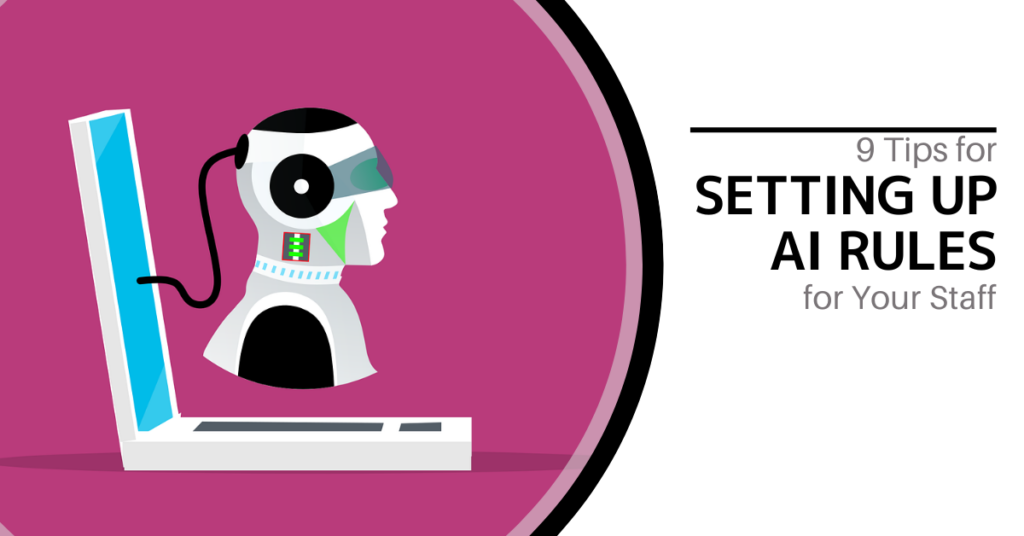|
Getting your Trinity Audio player ready...
|

How to Establish Effective Guidelines for Artificial Intelligence in the Workplace
Artificial intelligence (AI) has the potential to significantly boost your team’s productivity, efficiency, and creativity. However, the adoption of artificial intelligence also brings unique challenges and risks. To make the most of AI, businesses need to manage these risks and set clear guidelines for its use.
Creating ethical and clear “AI rules” for staff is crucial. Without well-defined rules, employees might not know when or how to use AI for business purposes. On the other hand, they may avoid using AI altogether, missing out on substantial time savings.
In fact, 64% of businesses anticipate that AI will enhance productivity. In this article, we’ll provide practical tips for setting up AI rules for your staff. These guidelines will help you maximize the benefits of artificial intelligence while mitigating potential downsides.
Define the Scope and Purpose of Artificial Intelligence Use
Before implementing AI in your workplace, it is important to have a clear understanding of its purpose. Define how AI aligns with your business goals and objectives, and communicate this vision to your team. Explain how artificial intelligence will support their roles, improve their performance, and enhance overall outcomes. This clarity will help set realistic expectations and prevent confusion or frustration.
Establish Ethical Principles and AI Guidelines
AI can impact not only your employees but also your customers, partners, and the broader community. It’s essential to ensure that your use of AI is ethical, fair, transparent, and accountable. Develop a set of ethical principles and guidelines that reflect your company’s values and adhere to legal requirements. Educate your staff on these guidelines and monitor compliance to maintain trust and integrity.
Involve Stakeholders in the AI Decision-Making Process
Setting rules for artificial intelligence should not be a top-down mandate. Involve key stakeholders, including employees from different departments, in the decision-making process. This collaborative approach ensures that AI rules consider diverse perspectives and needs. It also fosters a sense of ownership and engagement among team members, leading to more effective implementation.
Assign Clear Roles and Responsibilities
Artificial intelligence is a powerful tool, but it cannot replace human judgment or oversight. Define specific roles and responsibilities for your staff in relation to AI systems. Clearly outline who is responsible for the design, development, deployment, maintenance, auditing, and updating of AI tools. Additionally, establish accountability for the outcomes and impacts of AI use, and support your employees with training and change management.
Provide Training and Ongoing Support for Artificial Intelligence
Equip your staff with the skills they need to work effectively alongside artificial intelligence. Offer comprehensive training programs that cover the basics of AI technology, its applications within your organization, and guidelines for interacting with AI systems. Providing continuous support will ensure that employees feel confident and competent in their AI-enhanced roles.
Prioritize Data Security and Privacy
Artificial intelligence systems often rely on large volumes of data, making data security and privacy critical concerns. Communicate clearly about the measures taken to protect sensitive information and adhere to data protection laws. Establish a strong cybersecurity framework to safeguard both employee and organizational data from potential breaches.
Implement a Feedback Loop for Artificial Intelligence Usage
Create a system for collecting feedback from employees about their experiences with artificial intelligence. This feedback loop will help identify areas for improvement, refine AI rules, and address any concerns or challenges that arise. Regular feedback promotes a culture of continuous improvement and helps ensure that AI tools are effectively supporting your team’s needs.
Regularly Review and Update AI Guidelines
Artificial intelligence is a rapidly evolving field, and your AI rules should evolve with it. Regularly review and update your guidelines to ensure they remain relevant, effective, and aligned with your business objectives. Evaluate the performance, outcomes, and impacts of AI use, and adjust your approach as needed to keep pace with new developments.
Foster a Growth Mindset for AI Adoption
Encourage a culture of curiosity and continuous learning within your organization. Promote a growth mindset that views artificial intelligence as a tool for augmenting human capabilities, not replacing them. Communicate that AI is designed to enhance employees’ skills, streamline processes, and allow them to focus on strategic and creative tasks.
Get Expert Help for Your AI Transformation
Artificial intelligence has the potential to transform your business if used wisely and responsibly. By following these tips, you can establish AI rules that help you harness the power of AI while minimizing risks.
Need expert guidance for your digital or AI transformation? Contact us today to schedule a consultation.
Twintel has grown into an expansive, full team of IT services professionals, acting as the outsourced IT department of non-profits, small to mid-size businesses, and enterprise-level corporations in Orange County, across California, and nationally.
Today, it’s the strength and deep expertise of the Twintel team that drives positive outcomes for clients. Each of the support staff, technicians, and engineers works diligently each day to make sure that the companies served have the seamless, secure, and stable IT environments needed to allow them to pursue their organizational objectives.